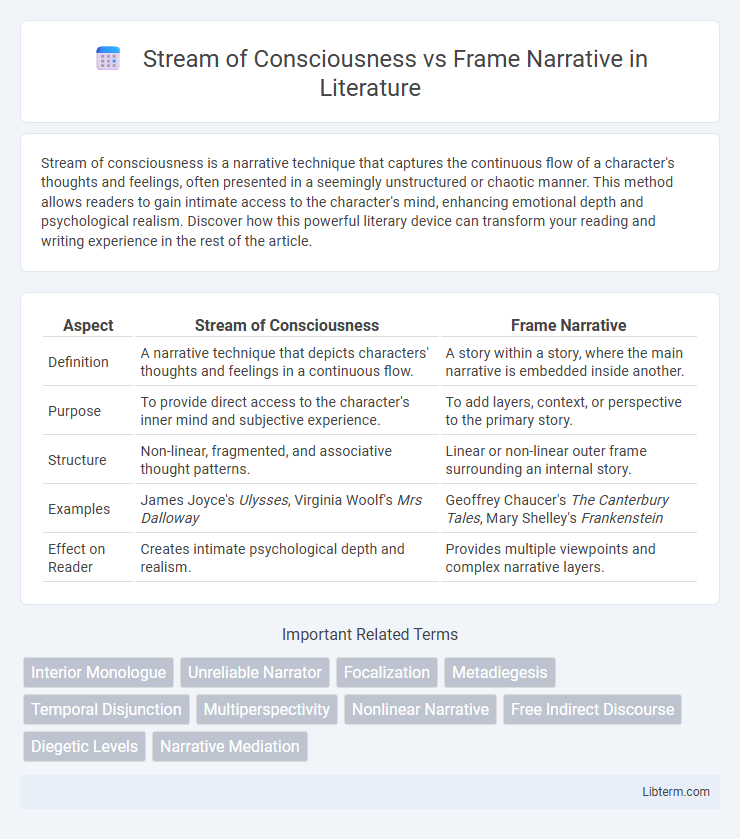Stream of consciousness is a narrative technique that captures the continuous flow of a character's thoughts and feelings, often presented in a seemingly unstructured or chaotic manner. This method allows readers to gain intimate access to the character's mind, enhancing emotional depth and psychological realism. Discover how this powerful literary device can transform your reading and writing experience in the rest of the article.
Table of Comparison
| Aspect | Stream of Consciousness | Frame Narrative |
|---|---|---|
| Definition | A narrative technique that depicts characters' thoughts and feelings in a continuous flow. | A story within a story, where the main narrative is embedded inside another. |
| Purpose | To provide direct access to the character's inner mind and subjective experience. | To add layers, context, or perspective to the primary story. |
| Structure | Non-linear, fragmented, and associative thought patterns. | Linear or non-linear outer frame surrounding an internal story. |
| Examples | James Joyce's Ulysses, Virginia Woolf's Mrs Dalloway | Geoffrey Chaucer's The Canterbury Tales, Mary Shelley's Frankenstein |
| Effect on Reader | Creates intimate psychological depth and realism. | Provides multiple viewpoints and complex narrative layers. |
Introduction to Narrative Techniques
Stream of consciousness is a narrative technique that captures the continuous flow of a character's thoughts and feelings, often presented in a seemingly unstructured or nonlinear manner to mirror natural cognition. Frame narrative structures a story within another story, providing context and perspective by embedding one narrative inside the main storyline. Both techniques enrich literary works by offering distinct ways to explore character psychology and plot development, enhancing reader engagement and thematic depth.
Defining Stream of Consciousness
Stream of consciousness is a literary technique that captures a character's continuous flow of thoughts, feelings, and sensory experiences, often presented in an unstructured or fragmented manner to mimic natural cognition. This method emphasizes internal monologue and subjective perception, allowing readers intimate access to the protagonist's mind. Unlike a frame narrative that organizes stories within structured boundaries, stream of consciousness prioritizes fluidity and spontaneity in storytelling.
Understanding Frame Narrative
Frame narrative is a literary technique that uses a story within a story to provide context and depth, often linking multiple narratives through a single overarching plot or narrator. This structure allows readers to engage with different perspectives and timelines while maintaining cohesion through the primary framing story. Understanding frame narratives enhances appreciation of complex storytelling by highlighting how embedded tales contribute to thematic richness and narrative layering.
Historical Origins and Evolution
Stream of consciousness emerged in early 20th-century modernist literature, pioneered by writers like James Joyce and Virginia Woolf, who sought to depict characters' inner thoughts and emotions in a continuous flow. Frame narrative, with roots tracing back to ancient storytelling traditions such as "One Thousand and One Nights" and Geoffrey Chaucer's "The Canterbury Tales," evolved as a structural device that encloses stories within an overarching narrative context. Both techniques have influenced narrative complexity and reader engagement, with stream of consciousness emphasizing psychological depth and frame narrative providing multi-layered story frameworks throughout literary history.
Key Features of Stream of Consciousness
Stream of consciousness is a narrative technique that captures the continuous, often chaotic flow of a character's thoughts and feelings, presented without conventional structure or punctuation. It relies heavily on interior monologue, fragmented sentences, and associative leaps that mimic natural mental processes, creating deep psychological insight. Unlike frame narrative, which organizes stories within stories and maintains clear boundaries, stream of consciousness immerses readers directly into the protagonist's mind, emphasizing raw, subjective experience.
Essential Elements of Frame Narrative
Frame narrative centers on a story within a story structure, where an outer narrative sets the stage for one or more inner tales, creating multiple layers of perspective. Essential elements include a distinct framing story that provides context, a clear boundary between the frame and the embedded narratives, and thematic or narrative links that unify the inner and outer stories. This technique enhances depth and complexity, allowing exploration of varying viewpoints and temporal shifts while maintaining coherence across intertwined narratives.
Comparative Analysis: Structure and Flow
Stream of Consciousness utilizes a nonlinear, free-flowing structure that mirrors a character's uninterrupted thoughts and sensory experiences, often lacking clear transitions or chronological order. Frame Narrative employs a structured, layered approach by embedding one or more stories within an overarching setting or narrator, providing clarity and context while maintaining distinct boundaries between narratives. The flow in Stream of Consciousness is intuitive and immersive, contrasting with Frame Narrative's deliberate pacing and segmented organization, which guides readers through multiple narrative levels with intentional coherence.
Notable Works and Authors
Stream of consciousness is exemplified in James Joyce's *Ulysses* and Virginia Woolf's *Mrs. Dalloway*, where interior monologues reveal characters' thoughts and emotions in real time. Frame narrative is notably used in Emily Bronte's *Wuthering Heights* and Mary Shelley's *Frankenstein*, employing nested stories within a larger narrative to provide multiple perspectives. Both techniques have been influential in modernist and Gothic literature, shaping the way stories explore psychological depth and complex storytelling structures.
Impact on Reader Engagement
Stream of consciousness immerses readers in a character's unfiltered thoughts and emotions, creating an intimate, often intense experience that deepens emotional connection and insight. Frame narrative structures provide a layered perspective by embedding stories within stories, enhancing engagement through narrative complexity and varied viewpoints. Both techniques captivate readers by offering distinct ways to explore character psychology and thematic depth, influencing emotional involvement and interpretive participation.
Choosing the Right Technique for Your Story
Stream of consciousness immerses readers in a character's inner thoughts and feelings through a continuous, unfiltered flow of narration, ideal for exploring complex psychological states. Frame narrative, structuring a story within another story, provides context and perspective, enhancing thematic depth and allowing multiple viewpoints. Selecting between these techniques depends on whether the focus is on deep character introspection or on presenting layered storytelling and varied perspectives.
Stream of Consciousness Infographic

 libterm.com
libterm.com